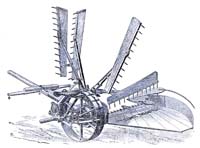|
Home > Victorian America > Economics > Farming & Agriculture

|
With its wide open spaces, one of the great attractions of America to residents and immigrants alike was its suitability for agriculture. Vast plantations, farms, and ranches spread across the landscape in the 19th century. This section looks at American agriculture as an industry, with such fascinating (?) facts as statistics on the production of cotton and cereals, tips on raising livestock, and so forth. Our Rural Life section looks at more personal pieces on farm life and country living in general.
|
- A New National Product - Beet-Root Sugar
(Godey's, 1863)
- Scientific Farming
(Atlantic Monthly, 1865)
- A delightful article that takes one on a rhapsodic tour of a classic American farm.
- The First Century of the Republic #7: Agricultural Progress, by William H. Brewer
(Harper's Monthly, 1875A)
- Everything from sheep to cheese manufacture. (Read the complete series.)
- Butter and Cheese
(Harper's Monthly, 1875B)
- How dairy farming is handled, with statistics on dairy production in the US.
- Gentleman Farming
(Harper's Monthly, 1875B)
- Young Man, Go West
(Harper's Monthly, 1881A)
- A look at the Close Colony of Iowa, with interesting details about the costs of farming and other ventures of the period.
- The Atlanta Cotton Exposition
(Century Magazine, 1882A)
- A look at a host of new machines and technologies for planting, harvesting and processing cotton.
- Significant Aspects of the Atlanta Cotton Exposition
(Century Magazine, 1882A)
- The Bee-Pastures of California, by George Waring Jr. (Part 1), John Muir (Part 2)
(Century Magazine, 1882B)
- Principal Cereal Productions of the US
(Collier's Cyclopedia, 1882)
- Total [US] Cotton Production and Average Product Per Acre
(Collier's Cyclopedia, 1882)
- Outdoor Industries in Southern California
(Century Magazine, 1883B)
- Under the Olives, by E.D.R. Bianciardi
(Century Magazine, 1883B)
- The cultivation of olives in America.
- Merinos in America, by Rowland E. Robinson
(Century Magazine, 1884A)
- A look at the history of merino sheep, which originated in Spain, and their transition to America.
- Agriculture and Farm Management, by Dr. William S. Roland
(Pennsylvania Board of Agriculture, 1886)
- Expectations and Experience [in Stock-Breeding], by H.H. Colvin
(Pennsylvania Board of Agriculture, 1886)
- The Fence Laws of Pennsylvania, by Hon. George W. Hood
(Pennsylvania Board of Agriculture, 1886)
- How [Farming] Success Is Achieved, by M.W. Oliver
(Pennsylvania Board of Agriculture, 1886)
- Pennsylvania State Fair 1886
(Pennsylvania Board of Agriculture, 1886)
- A look at the various new types of equipment and farm machinery (and some household devices) introduced at the State Fair.
- Some Recent Experiments in [Wheat] Hybridization, by Charles Barnard
(Century Magazine, 1886A)
- Thorough-Bred Stock for the Farmer, by Emery Davis
(Pennsylvania Board of Agriculture, 1886)
- Tips on choosing and improving one's stock.
- What Advantages Does Agriculture Offer a Young Man About to Choose an Occupation? by Gabriel Heister
(Pennsylvania Board of Agriculture, 1886)
- Many, this author believes, including true happiness.
- What Farmers Most Need to Know, by Hon. John A. Woodward
(Pennsylvania Board of Agriculture, 1886)
- The importance of recognizing farming as a professional and scientific enterprise.
- Will Better Farming Pay? by John I. Carter
(Pennsylvania Board of Agriculture, 1886)
- "The farming of a community can be greatly bettered, in a way, too, that is entirely safe, by a closer attention to many of the minor details of farming that are too frequently overlooked or neglected, and although each neglect may be small in itself, yet their reform will aggregate a wonderful change in the appearance and wealth of a farming neighborhood."
- The Food Question in America and Europe, by Edward Atkinson
(Century Magazine, 1887A)
- Extensive statistics about food production, costs of transportation, types of foods consumed in different parts of the country, "public victualling" and more.
- American Farming for Women
(Cassell's Family Magazine, 1890)
- The Outlook in Southern California, by Charles Dudley Warner
(Harper's Monthly, 1891A)
- Various types of farming and agriculture in Southern California.
- About Fruit Ranching, by Hugh Marshall
(English Illustrated Magazine, 1892A)
- Vineyards and orchards in the Santa Ana Valley of California.
- The Discontent of the Farmer, by J.R. Dodge
(Century Magazine, 1892A)
- Reactions to severe depressions in prices for farm products.
- The Farmer and Railway Legislation, by Henry C. Adams
(Century Magazine, 1892A)
- The Food-Supply of the Future, by W.O. Atwater
(Century Magazine, 1892A)
- Addressing the question of whether the population of the world would eventually outstrip the earth's ability to feed it.
- What the Government is Doing for the Farmer, by A.W. Harris
(Century Magazine, 1892B)
- Pests, by Warren Cooper
(The Strand, 1897B)
- How Americans battle such pets as locusts, moths, rabbits, and invasive plants.
- Harvesting in Far California, by C. Fell Smith
(Windsor Magazine, 1899B)
- California provides "amazing quantities of everything, from acres of calla lilies to thousands of tons of castor-oil beans, or millions of quarters of wheat."
- America and the World's Wheat Supply, by Ray Stannard Baker
(Windsor Magazine, 1900B)
- One statistician projected that by 1931, the world would no longer produce enough wheat for its population. In Britain at the time of this article, the entire wheat supply produced in country lasts for 13 weeks, whereupon Britain must import the rest of its annual supply from America, Russia and India.
- • See also Rural & Country Life
|
Visit Our Victorian Shop
for:
Books
Coloring Books
Beautiful Spiral Journals
Holiday Greeting Cards
|
|


 Discover thousands of Victorian images in our
Discover thousands of Victorian images in our 